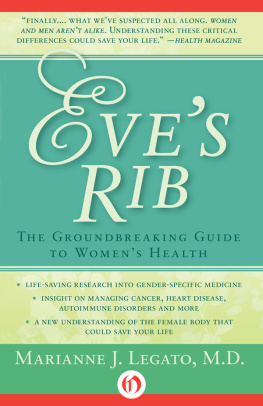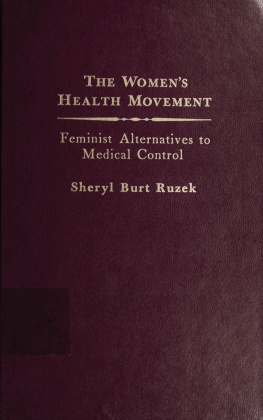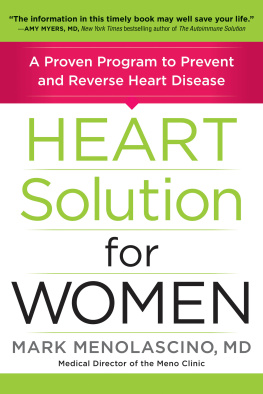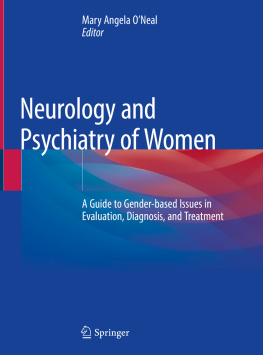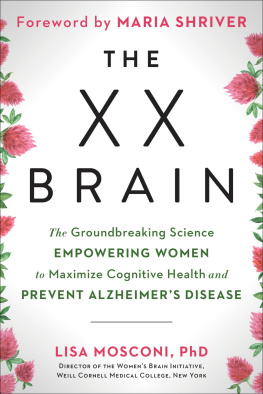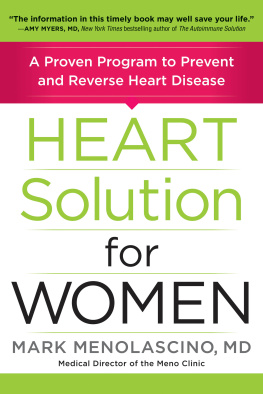Eves Rib
The Groundbreaking Guide to Womens Health
Marianne J. Legato, M.D.

For Christiana and Justin
Acknowledgments
Writing this book was tremendously enhanced by the following people:
Harmony Books Shaye Areheart, who convinced me that the lay public needed and would welcome the new information about gender-based medicine, and who believed I could write Eves Rib.
Richard and Leslie Curtis, whose encouragement, multiple readings, and intelligent critiques helped me polish, focus, and sculpt the final manuscript.
Peter Guzzardi, my line editor, who cajoled, pummeled, and urged me on until the last line in the last paragraph of the last chapter mad coherent sense.
Christiana Killian, whose readingsand rereadingsof each chapter prompted some of the best suggestions for clarifying my thought I could have had.
John Pepper, Myron Weisfeldt, Craig Wynett, and T. George Harristhe four men who made the Partnership for Womens Health at Columbia University a reality.
Christine Haider and Palesta Fitzgerald, whose loyalty, support and skill are vital to the research and educational mission of the partnership.
My patients, who have taught me so much.
Introduction
Eves Rib is not just about womens health, but about the health of both sexes and the new science of gender-specific medicine. Until now weve acted as though men and women were essentially identical except for the differences in their reproductive function. In fact, information weve been gathering over the past ten years tells us that this is anything but true, and that everywhere we look, the two sexes are startlingly and unexpectedly different not only in their normal function but in the ways they experience illness.
As a rigorously trained biomedical scientist, Ive always been interested in the excitement of exploring a new idea and finding out how to prove it true or false. Until the last decade, weve made the assumption in medicine that its necessary to study only men, and that the data we harvest can be extrapolated to women without modification. To a certain extent, the assumption was forced upon us: studying women, particularly premenopausal women, is not without risk both to the subject herself and to a fetus that might be conceived during the course of an investigation. Thus, weve found it difficult to recruit women for stud; unless their reproductive years were behind them, and those supporting research have been justifiably wary of incurring huge damages as a consequence of harming an unborn child. Furthermore, because of the cyclic variations in younger womens hormonal levels, any investigation that included them would require larger numbers of them than of men to really come to a firm conclusion about whether or not gender differences exist. So weve excused ourselvesand womenfrom including them in biomedical investigation on the grounds of its being too dangerous and too expensiveeven unfeasible in terms of finding sufficient numbersto do so. But all that has begun toand mustchange.
It has been women themselves who have demanded a change in the way American scientists and doctors do business. With an increasingly more coherent and powerful voice, women have forced the federal government and the biomedical establishment it supports to define the differences between males and females. The results have been nothing short of astonishing. As we compare men and women, we are finding that in every system of the body, from the very hairs of our heads to the way our hearts beat, there are significant and unique sex-based differences in human physiology. The new data are transforming the way we prevent and treat disease. We are refashioning our male models of health and illness by asking questions we never even would have framed until we studied both sexes. The answers to those questions are turning out to be completely unexpected and fascinating.
We havent solved every problem about the difficulties in studying women, particularly those still involved in building their families. But as the Belmont conference observed, it is a principle of justice that if women are to share in the benefits of medical research, they must also share in the risk that research inevitably entails when we are testing the safety and usefulness of a new drug or intervention. Every woman who wants more attention to her health must be willing to help harvest the new information and bear a personal responsibility for helping to generate credible answers to the questions that we are asking.
Somehow, Eves gift of an apple to Adam became a metaphor for our banishment from an ideal world of perfect harmony to an existence troubled with suffering, sorrow, and eventually death. The reality is quite the opposite. If we are courageous, persistent, and intelligent about using Eves gift to expand the new science of gender-specific medicine, the next decade of research will inevitably produce significant improvements in our ability to improve and lengthen human life. Eves Rib explains why.
CHAPTER 1
Eves Question: How Am I Different from Adam?
Unless they are focusing on the reproductive system, most doctors have a tendency to treat patients as though they were all the same sex: male. We consider patients stories of their illnesses, examine their bodies, and interpret their laboratory tests as though gender were irrelevant. We even write prescriptions the same way, seldom considering patients size or body composition, let alone sex, to determine how their bodies will process and use a particular drug. Even our understanding of what makes men and women different has been simplistic. (Many doctors ascribe it all to hormones, which is only partly correct.) In short, weve practiced medicine as though only a womans breasts, uterus, and ovaries made her uniqueand as though her heart, brain, and every other part of her body were identical to those of a man. Its not that the profession is overrun with poorly educated sexist practitioners. For the most part, rather, its the way we have been educated, as though women were simply small men and data we have about the male body were the standard for both sexes. Most of the information doctors use in diagnosing and treating disease was gathered almost entirely from research on males. Remarkably, its only recently that medical science has begun to grapple with the complex factors that define a person as male or female.
The notion that women and men are essentially interchangeable isnt new. If you want to know what a culture holds to be most important and true, read its myths. Consider the story of Adam and Eve. As the crowning glory of the newly created world, God transforms some clay into the first humana male, perfect in every way. In spite of the abundant richness of Paradise, however, Adam is lonely. Consider God, on the fifth day, taking pity on Adam. He puts him into a deep sleep, takes some tissue from his side, and fashions it into a woman. Its not only a biblical tale, its also a medical fable, and an eerily prophetic one at that; it describes the first anesthesia, major surgery, and cloning of a new individual. More important, it tells us that Eve is literally derived from the stuff of Adam. Apart from their reproductive biology (which is admittedly unique for each, a fact with which the storys author never grapples), by definition Adam and Eve are identical: Eve is simply a smaller version of Adam.
Still, she is different enough, apparently, to want to explore beyond the boundaries set for them both: she wants more information; she wants answers to questions that only she has formulated. She tempts her hapless mate into an ill-fated collaboration to acquire that knowledge (which, she is assured by Satan, will give her more power over the world around her)and they are expelled from Paradise, condemned to a life full of effort, pain, and all the other assorted ills of the human condition. Although we cant know precisely what she wanted to ask, Ive always imagined that one of her questions was this: How am I different from Adam?

